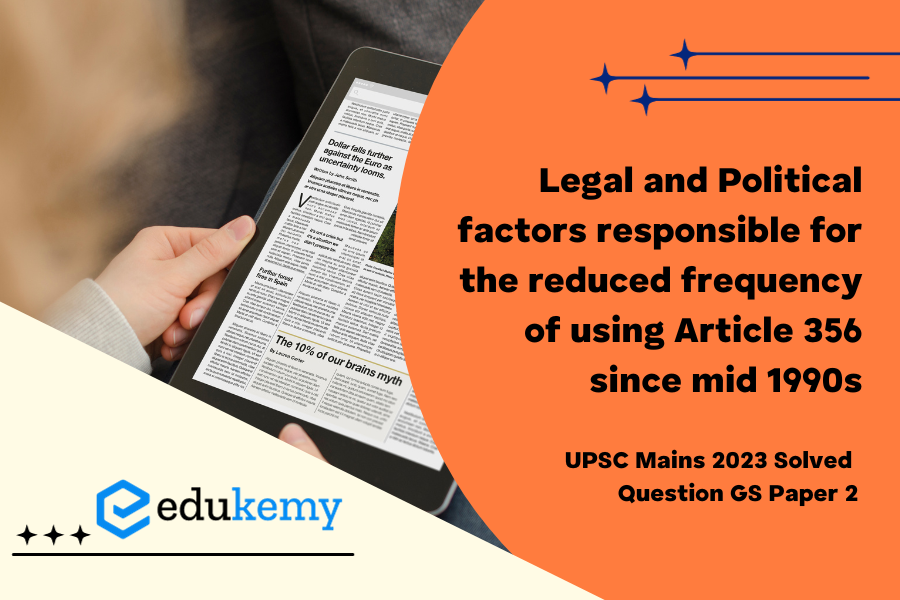UPSC Mains General Studies Paper – 1 Mains 2023
UPSC Mains Civil Services IAS Exam Question Paper – 2023
Contents
Introduction
The decreased usage of Article 356 by Union Governments since the mid-1990s can be attributed to legal and political factors. Legally, judicial activism and a more assertive judiciary have limited executive discretion. Politically, coalition governments and increased federalism compelled consensus-based decision-making, promoting cooperative federalism over coercive centralism. Additionally, growing public awareness and international scrutiny deterred arbitrary use, fostering a more democratic political culture.
Article 365 empowers the President of India to impose president rule in a state effectively dismissing the state government and taking control of its affairs in case when there is ‘ failure of constitutional machinery’.
Body
However, the frequency of using article 356 has been reduced since mid 1990s and this dismissal have been historically subjected to conflict due to the following factors:-
Legal factors:-
- SR Bommai case 1994 :- It emphasized that the power to dismiss a state government is subject to strict judicial review and should be used as a last resort. It also made it legally challengeable for the union to impose President rule. Ex- Uttarakhand president rule was stayed by Uttarakhand high court in 2017
- Constitutional Amendments :- It saw a transformation where in the 38th amendment act of 1975 made the satisfaction of the president in invoking Art-356 as final and conclusive whereas in the 44th amendment act of 1978 implies that the satisfaction of the president is not beyond Judicial review.
- Judicial Activism :- Under the Rameshwar Prasad vs Union of India case in 2005 a constitutional bench led by the chief justice of India declared the President’s proclamation dissolving the Bihar assembly as unconstitutional. This legal precedence set a high standard for the application of Art-356
- Formation of inter state council :- Implementation of Sarkaria commission report in which he talks about Art-356 to be used as a last resort. It can lead to enhanced cooperation between union and state government.
- Justice V. chellian commission (2002) :-Recommended that Art-356 must be used sparingly and only as a remedy of the last resort after exhausting all actions under Art-255, Art-257 and Art- 355.
- Punchhi Commission:- Recommends that these Art-355 and Art-356 must be amended in order to protect the interest of the states trying to curb their misuse by the Centre.
Political factors:-
- Active role of President:- Former President K.R Narayan returned the cabinet’s recommendation in 1997, to impose president’s rule in the state of UP.
- Coalition Politics:- The Political environment of 1990’s was deeply fragmented both at Centre and state level which made them more cautious about using Art-356
- Rise of regional parties :- It flavored opportunistic and volatile character to Indian polity. It led national parties to become more inclined towards regional parties for their own political stability in Rajya Sabha and maintaining power balance at Centre.
- Consensus building :- Dialogue and diplomacy is a new drift in resolving disputes and differences rather than resorting to the dismissal of state governments.
- Role of governor:- Former governor of Tamil Nadu Surjeet Singh Barmala refused to send a report to the central government recommending president rule in the state.
Other factors:-
- Role of media and technology leads to political awareness in civil society
- Upholding the idea of cooperative federalism.
- Role of Pressure groups.
Conclusion
Thus, over the years, the legal interventions along with the evolved political climate have been instrumental in reducing the frequency of invoking Article 356 making it a “dead letter” and has helped in fostering a harmonious and balanced federal structure
In case you still have your doubts, contact us on 8792740517.
For UPSC Prelims Resources, Click here
For Daily Updates and Study Material:
Join our Telegram Channel – Edukemy for IAS
- 1. Learn through Videos – here
- 2. Be Exam Ready by Practicing Daily MCQs – here
- 3. Daily Newsletter – Get all your Current Affairs Covered – here
- 4. Mains Answer Writing Practice – here


